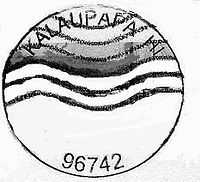Kalaupapa, Hawaii
| Kalaupapa | |
|---|---|
| Unincorporated community | |
 Most of the village of Kalaupapa as seen from an airplane. This photo also includes a section of the sea cliffs that form a natural barrier between the Kalaupapa Peninsula and "Topside" Molokaʻi. | |
| Coordinates: 21°11′22″N 156°58′54″W / 21.18944°N 156.98167°WCoordinates: 21°11′22″N 156°58′54″W / 21.18944°N 156.98167°W | |
| Country | United States |
| State | Hawaii |
| County | Kalawao |
| Elevation | 66 ft (20 m) |
| Population (2000) | |
| • Total | 122 |
| Time zone | Hawaii-Aleutian (UTC-10) |
| ZIP codes | 96742 |
| GNIS feature ID | 360096[1] |


Kalaupapa[2] is a small unincorporated community on the island of Molokaʻi in the U.S. state of Hawaii, within Kalawao County. They have an active post office[3] with a zip code of 96742.[4]
The village is located on the Kalaupapa Peninsula at the base of some of the highest sea cliffs in the world, dropping over 2,000 feet (610 m) to the Pacific Ocean.
Leprosy settlement
The village is the site of a former settlement for leprosy patients. The original leper colony was first established in Kalawao in the east, opposite to the village corner of the peninsula. It was there where Father Damien settled in 1873. Later it was moved to the location of the current village, which was originally a Hawaiian fishing village. The settlement was also attended by Mother Marianne Cope, among others. At its peak, about 1,200 men, women, and children were in exile in this island prison. The isolation law was enacted by King Kamehameha V and remained in effect until 1969, when it was finally repealed. Today, about fourteen former sufferers of leprosy (which is also known as Hansen's Disease) continue to live there.[5] The colony is now part of Kalaupapa National Historical Park.
Shortly before the end of mandatory isolation in 1969, the state legislature considered closing the facility entirely. Intervention by interested persons, such as entertainer Don Ho and TV newsman Don Picken, resulted in allowing the residents to remain there for life. The opponents to closure pointed out that, although there were no active cases of leprosy in existence, many of the residents were physically scarred by the disease to an extent which would make their integration into mainstream society difficult if not impossible.
References
- ↑ U.S. Geological Survey Geographic Names Information System: Kalaupapa, Hawaii
- ↑ U.S. Geological Survey Geographic Names Information System: Kalaupapa, Hawaii
- ↑ http://gohawaii.about.com/library/gallery/blkalaupapa_055.htm
- ↑ http://www.zipdatamaps.com/96742
- ↑ http://www.honoluluadvertiser.com/article/20090409/NEWS01/904090344/1190
Bibliography
- Nalaielua, Henry, with Sally-Jo Bowman. No Footprints in the Sand: A Memoir of Kalaupapa. Honolulu: Watermark, 2006. ISBN 978-0-9779143-0-2.
- Tayman, John. The Colony: The Harrowing True Story of the Exiles of Molokai. New York: Scribner's, 2006. ISBN 0-7432-3300-X.
External links
![]() Media related to Kalaupapa, Hawaii at Wikimedia Commons
Media related to Kalaupapa, Hawaii at Wikimedia Commons
- "Fear and Loathing in Hawaii: 'Colony'" (NPR Fresh Air, February 2 2006)
- "Last days of a leper colony" (CBS News article, March 22 2003)
- Jack London's "The Lepers Of Molokai"
 "Molokai". Catholic Encyclopedia. New York: Robert Appleton Company. 1913.
"Molokai". Catholic Encyclopedia. New York: Robert Appleton Company. 1913.- "Sheriff of Kalaupapa demystified disease" (Honolulu Star-Bulletin obituary, February 5 2008)
- "Newsman thrived amid 'shenanigans'" (Honolulu star Bulletin, December 1 2008)
- Pictopia.org 1667769 (26-Kalaupapa, HI-1) Plan for Proposed Lighthouse Keeper's House
| ||||||||||||||||||||||||||
| ||||||||||||||||
